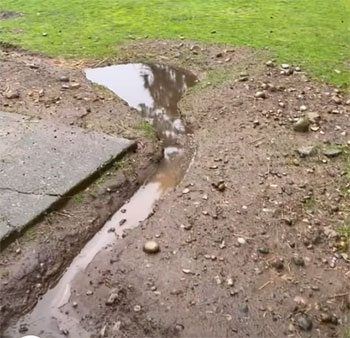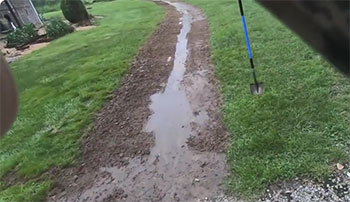Ah, the great outdoors – a realm where lush lawns, vibrant gardens, and serene landscapes are the epitome of homeowner pride and joy. But amidst the natural beauty lies a hidden hero, often overlooked yet invaluable in its role: the humble swale. This unassuming trench, carefully crafted to channel and redirect water flow, is the unsung guardian against flooding, erosion, and water-related woes.
But alas, even the most meticulously designed swale is not immune to the trials and tribulations of nature’s whims. From clogging and overflowing to erosion and maintenance mishaps, swale drainage problems can quickly turn a picturesque paradise into a waterlogged nightmare.
Fear not, dear reader, for we shall delve into the depths of swale drainage dilemmas, shedding light on the common culprits and equipping you with the knowledge and practical solutions to conquer even the most stubborn of drainage issues.
So, grab your metaphorical shovel, and let’s embark on a journey through the world of swale drainage, where we’ll unearth the secrets to a well-functioning, hassle-free system that keeps your landscape looking its best, come rain or shine.
The Clogging Conundrum
One of the most prevalent swale drainage problems is the dreaded clog. Like a stubborn blockage in a drain, these obstructions can prevent water from flowing freely, leading to pooling, erosion, and a whole host of headaches.
Debris and Sediment Buildup

As water flows through the swale, it carries with it a variety of debris and sediment, ranging from leaves and twigs to soil and gravel. Over time, this accumulation can create a barrier that restricts water flow, causing it to back up and potentially overflow the swale’s boundaries.
Vegetation Overgrowth
While swales are designed to channel water, they can also become a breeding ground for unwanted vegetation. Weeds, grass, and even small shrubs can take root within the swale, their roots and foliage creating a tangled mess that impedes water flow and traps debris.
Animal Activity
Furry friends like moles, voles, and even larger critters like deer or raccoons can also contribute to swale drainage problems. Their burrowing and trampling activities can disrupt the swale’s structure, creating holes and compacting soil, ultimately leading to water stagnation and potential flooding.
Erosion Enigmas
Erosion is another common foe when it comes to swale drainage. While swales are designed to control water flow, improper design or maintenance can lead to the very erosion they’re meant to prevent.
Insufficient Slope or Grading
Proper slope and grading are crucial for swale effectiveness. If the swale doesn’t have enough incline, water can become stagnant, allowing sediment to accumulate and creating an environment ripe for erosion. Conversely, if the slope is too steep, water can rush through with such force that it erodes the swale’s walls and bottom, compromising its integrity.
Lack of Vegetation or Lining
A well-designed swale should have adequate vegetation or a suitable lining to protect against erosion. Bare soil is more susceptible to the erosive forces of water, leading to the formation of gullies and rills that can quickly deepen and widen, potentially rendering the swale ineffective.
High-Velocity Water Flow
In areas prone to heavy rainfall or runoff, the influx of high-velocity water can overwhelm the swale’s capacity, causing erosion and potentially leading to breaches or even complete failure of the drainage system.
Maintenance Mayhem
Even the most well-designed and properly installed swale requires regular maintenance to ensure its longevity and effectiveness. Neglecting this crucial aspect can quickly lead to a host of drainage problems.
Lack of Debris Removal

As mentioned earlier, debris buildup is a common issue in swales. Failing to remove this debris can not only lead to clogs but also provide a breeding ground for unwanted vegetation and pests, further compounding the drainage problems.
Insufficient Vegetation Management
While vegetation is essential for erosion control, overgrowth can be just as detrimental as a lack thereof. Neglecting to trim or remove excess growth can lead to clogging, as well as create an environment that attracts pests and wildlife, potentially exacerbating drainage issues.
Ignoring Structural Degradation
Over time, swales can succumb to the elements, with soil erosion, compaction, and even structural damage from animal activity or heavy machinery. Ignoring these signs of degradation can lead to breaches, collapses, and ultimately, the failure of the entire drainage system.
Overflowing Overload
When all else fails and the swale’s capacity is exceeded, the dreaded overflow situation can occur. This can lead to a cascade of problems, ranging from water damage to your property to potential safety hazards.
Flooding and Water Damage
If the swale overflows, water can inundate your yard, garden, or even seep into your home’s basement or crawl spaces, causing significant water damage and potentially leading to mold growth or structural issues.
Soil Erosion and Landscape Destruction
Uncontrolled water flow can wreak havoc on your carefully cultivated landscaping, eroding soil, washing away mulch, and even uprooting plants and shrubs. This can not only ruin your property’s aesthetic appeal but also compromise the integrity of your landscape’s drainage system.
Safety Concerns
In extreme cases, swale overflows can create safety hazards, such as deep puddles or standing water that can pose a risk for slips, falls, or even drowning in severe situations. This is particularly concerning for households with small children or pets who may be drawn to these water features.
FAQs
While rocks can be used in swales, they should be placed strategically and with caution. Rocks can help stabilize the swale’s walls and bottom, reducing erosion, but they can also create obstructions and impede water flow if not properly installed. It’s generally recommended to consult with a professional to ensure proper rock placement and sizing.
The duration that water can safely remain in a swale depends on various factors, including the swale’s design, soil type, and local climate. In general, water should not sit for more than 24-48 hours, as stagnant water can lead to mosquito breeding, odors, and potential environmental concerns.
The recommended distance between a swale and a house can vary based on local regulations and site-specific conditions. However, a general guideline is to place the swale at least 10-20 feet away from the foundation to prevent water from seeping into the basement or crawl space.
The lifespan of a swale can range from several years to decades, depending on factors such as the quality of construction, soil conditions, maintenance practices, and exposure to erosive forces. Well-designed and properly maintained swales can last 20-30 years or more, while neglected or poorly constructed swales may need to be replaced or repaired within 5-10 years.
Also Read: Why Is Roto-Rooter So Expensive? A Closer Look!
Conclusion
As we’ve explored the various swale drainage problems and their potential causes, one thing is abundantly clear: maintaining a well-functioning swale requires vigilance, proper maintenance, and a proactive approach to addressing issues before they spiral out of control.
From clogging and erosion to overflowing and maintenance mishaps, these drainage dilemmas can quickly turn a serene landscape into a waterlogged nightmare. But fear not, dear reader, for armed with the knowledge and practical solutions we’ve discussed, you now possess the power to conquer even the most stubborn swale drainage woes.
Remember, your swale is more than just a trench in your yard – it’s a vital component of your property’s drainage system, working tirelessly to protect your home and landscape from the ravages of uncontrolled water flow. By staying on top of maintenance, addressing issues promptly, and ensuring proper design and installation, you can not only extend the lifespan of your swale but also safeguard your investment and preserve the beauty of your outdoor oasis.
So, embrace your inner landscape guru, roll up your sleeves, and take charge of your swale’s performance. With a little elbow grease, a keen eye for detail, and the right mindset, you can ensure that your drainage woes become a distant memory, leaving you free to enjoy the serenity of a well-maintained, worry-free landscape.
